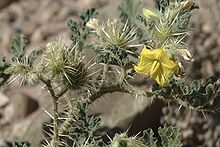Solanum rostratum
| Solanum rostratum | |
|---|---|

| |
| Scientific classification | |
| Kingdom: | Plantae |
| Clade: | Tracheophytes |
| Clade: | Angiosperms |
| Clade: | Eudicots |
| Clade: | Asterids |
| Order: | Solanales |
| Family: | Solanaceae |
| Genus: | Solanum |
| Subgenus: | Solanum subg. Leptostemonum |
| Section: | Solanum sect. Crinitum |
| Species: | S. rostratum
|
| Binomial name | |
| Solanum rostratum | |
| Synonyms | |
|
Solanum cornutum auct.[2] | |
Solanum rostratum is a species of nightshade (genus Solanum) that is native to the United States and northern and central Mexico.[2] Common names include buffalobur nightshade,[3] buffalo-bur,[4] spiny nightshade, Colorado bur, Kansas thistle, bad woman, Mexican thistle, and Texas thistle.
It is an annual, self-compatible herb that forms a tumbleweed.[5] Individual plants reach 1–1.5 m (3.3–4.9 ft) tall, have once or twice pinnatified leaves (see image of leaf), and abundant spines on the stems and leaves. It produces yellow flowers with pentagonal corollas 2–3.5 cm (0.79–1.38 in) in diameter and weakly bilaterally symmetric (see flower-closeup image).[6] In its native range S. rostratum is pollinated by medium- to large-sized bees including bumblebees.[7]
Solanum rostratum flowers exhibit heteranthery, i.e. they bear two sets of anthers of unequal size, possibly distinct colouration, and divergence in ecological function between pollination and feeding.[8] The fruit, a berry, is enclosed by a prickly calyx. The seeds are released when the berries dry and dehisce (split apart) while still attached to the plant.
This species represents one of the later scientific interests of famed biologist Charles Darwin, who just over a week prior to his death had ordered seeds from a colleague in America, so as to investigate their heteranthery, a topic he was interested in.[9]
Solanum rostratum is the ancestral host plant of the Colorado potato beetle, Leptinotarsa decemlineata, but this pest adopted the potato, Solanum tuberosum as a new (and more succulent) host, a fact first reported in eastern Nebraska in 1859. It then expanded its range rapidly eastward on potato crops in the next two decades.[10] Can be invasive.
References
[edit]- ^ "NatureServe Explorer 2.0". explorer.natureserve.org.
- ^ a b "Solanum rostratum". Germplasm Resources Information Network. Agricultural Research Service, United States Department of Agriculture. Retrieved 7 June 2010.
- ^ USDA, NRCS (n.d.). "Solanum rostratum". The PLANTS Database (plants.usda.gov). Greensboro, North Carolina: National Plant Data Team. Retrieved 17 November 2015.
- ^ BSBI List 2007 (xls). Botanical Society of Britain and Ireland. Archived from the original (xls) on 2015-06-26. Retrieved 2014-10-17.
- ^ Louis Hermann Pammel (1903). Some Weeds of Iowa. Experiment Station, Iowa State College of Agriculture and the Mechanic Arts. page 477
- ^ Whalen, M.D. (1979). "Taxonomy of Solanum section Androceras". Gentes Herbarum. 11 (6): 359–426.
- ^ Bowers, K.A.W. (1975). "The pollination ecology of Solanum rostratum (Solanaceae)". American Journal of Botany. 62 (6): 633–8. doi:10.1002/j.1537-2197.1975.tb14094.x. JSTOR 2441943.
- ^ Vallejo-Marin, M.; Manson, J.S.; Thomson, J.D.; Barrett, S.C.H. (2009). "Division of labour within flowers: Heteranthery, a floral strategy to reconcile contrasting pollen fates". Journal of Evolutionary Biology. 22 (4): 828–839. doi:10.1111/j.1420-9101.2009.01693.x. hdl:1893/942. PMID 19320798. S2CID 36383835.
- ^ Buchmann, S.L. (1983). "Buzz pollination in angiosperms". In Jones, C.E.; Little, R.J. (eds.). Handbook of experimental pollination biology. Van Nostrand Reinhold. pp. 73–113. ISBN 0442246765.
- ^ Riley CV. 1876. Potato Pests. New York, Orange Judd Co., 108pp.
External links
[edit]![]() Media related to Solanum rostratum at Wikimedia Commons
Media related to Solanum rostratum at Wikimedia Commons
![]() Data related to Solanum rostratum at Wikispecies
Data related to Solanum rostratum at Wikispecies





